
"The Last Long Mile", also known as the "Plattsburg Marching Song", is a World War I-era marching song written in 1917. The song is attributed to Emil Breitenfeld, who wrote the song while serving as a lieutenant in the United States Army.

"The Last Long Mile", also known as the "Plattsburg Marching Song", is a World War I-era marching song written in 1917. The song is attributed to Emil Breitenfeld, who wrote the song while serving as a lieutenant in the United States Army.
"The Last Long Mile" was originally composed by Emil Breitenfeld while the musician was training with the 17th New York Regiment in Plattsburgh, New York. [1] The song—originally known as either "The Long Last Mile" or the "Plattsburg Marching Song"—quickly became popular with soldiers, and was presented along with other soldier's compositions to the National Board on Army and Navy Camp Music. The board liked the song, and considered it one of the best songs to have been produced in soldier's camps. [1] The song was later featured in the first issue of Music in the Camps, an activity book produced for army and navy training camps. [1]
The song, now renamed "The Last Long Mile", was later featured in Toot Toot (1918), a Broadway musical produced by Henry W. Savage and published by T. B. Harms & Francis, Day & Hunter, Inc. [2] [3]
Following the war and his exit from the army in 1919, Breitenfeld moved to California and wrote music for silent films and stage plays. [4] He was the father of Paul Desmond. [5]
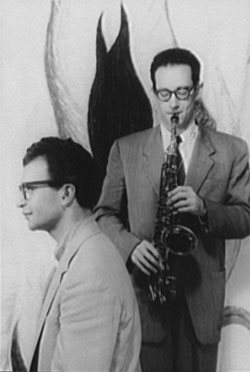
Paul Desmond was an American jazz alto saxophonist and composer and proponent of cool jazz. He was a member of the Dave Brubeck Quartet and composed that group's biggest hit, "Take Five".

"John Brown's Body" is a United States marching song about the abolitionist John Brown. The song was popular in the Union during the American Civil War. The song arose out of the folk hymn tradition of the American camp meeting movement of the late 18th and early 19th century. According to an 1889 account, the original John Brown lyrics were a collective effort by a group of Union soldiers who were referring both to the famous John Brown and also, humorously, to a Sergeant John Brown of their own battalion. Various other authors have published additional verses or claimed credit for originating the John Brown lyrics and tune.

Gustav Gerson Kahn was an American lyricist who contributed a number of songs to the Great American Songbook, including "Pretty Baby", "Ain't We Got Fun?", "Carolina in the Morning", "Toot, Toot, Tootsie ", "My Buddy" "I'll See You in My Dreams", "It Had to Be You", "Yes Sir, That's My Baby", "Love Me or Leave Me", "Makin' Whoopee", "My Baby Just Cares for Me", "I'm Through with Love", "Dream a Little Dream of Me" and "You Stepped Out of a Dream".
The Preparedness Movement was a campaign led by former Chief of Staff of the U.S. Army, Leonard Wood, and former President Theodore Roosevelt to strengthen the U.S. military after the outbreak of World War I. Wood advocated a summer training school for reserve officers to be held in Plattsburgh, New York.
"It's a Long Way to Tipperary" is an English music hall song first performed in 1912 by Jack Judge, and written by Judge and Harry Williams, though authorship of the song has long been disputed.
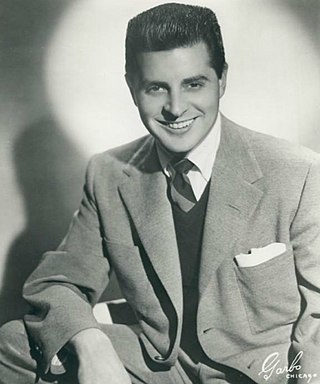
Johnny Desmond was an American singer and actor who was popular in the 1940s, 1950s and 1960s.
Citizens' Military Training Camps (CMTC) were military training programs of the United States. Held annually each summer during the years 1921 to 1940, the CMTC camps differed from National Guard and Organized Reserve training in that the program allowed male citizens to obtain basic military training without an obligation to call-up for active duty. The CMTC were authorized by the National Defense Act of 1920 as a compromise that rejected universal military training. In its nearly two decades of operation, the CMTC trained some 400,000 men in at least one season from 1921 to 1940. Overall the program was disappointing, as only 5,000 officer commissions were awarded to men who completed the required four summers of training.
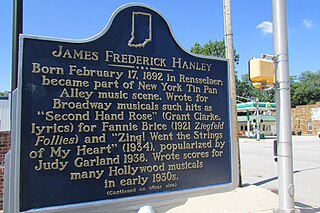
James Frederick Hanley was an American songwriter and author.
A war song is a musical composition that relates to war, or a society's attitudes towards war. They may be pro-war, anti-war, or simply a description of everyday life during war times.

"Keep the Home-Fires Burning " is a British patriotic First World War song composed in 1914 by Ivor Novello with words by Lena Guilbert Ford.

During the American Civil War, music played a prominent role on both sides of the conflict, Union and Confederate. On the battlefield, different instruments including bugles, drums, and fifes were played to issue marching orders or sometimes simply to boost the morale of one's fellow soldiers. Singing was also employed not only as a recreational activity but as a release from the inevitable tensions that come with fighting in a war. In camp, music was a diversion away from the bloodshed, helping the soldiers deal with homesickness and boredom. Soldiers of both sides often engaged in recreation with musical instruments, and when the opposing armies were near each other, sometimes the bands from both sides of the conflict played against each other on the night before a battle.

Merch Bradt Stewart, often called M. B. Stewart was a writer, educator, and career United States Army officer who became superintendent of the United States Military Academy. Stewart authored several U.S. Army manuals, penned a popular narrative of his considerable experiences as second lieutenant in the Spanish–American War, and in the years preceding World War I wrote essays informing the public on issues of physical and military education.

Enoch Barton Garey was a military expert and author of numerous textbooks including The Plattsburg Manual: A Handbook for Federal Training Camps. He was a Maryland native who served as a major in World War I and as superintendent of the Maryland State police.
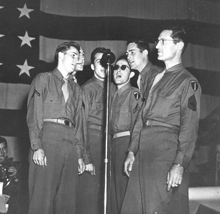
The Crew Chiefs were a vocal group popular in the 1940s, known for accompanying Tex Beneke, Glenn Miller, and Ray McKinley. Member Artie Malvin co-wrote the song "I'm Headin' For California" with Glenn Miller in 1944.
The 307th Infantry Regiment was a National Army unit first organized for service in World War I as part of the 77th Division in France. It later served in the Pacific Theater during World War II. Since then it has served as a training Regiment. In 1999, it was withdrawn from the Combat Arms Regimental System and redesignated as a non-branch regiment. The regiment's 1st Battalion is assigned to the 174th Infantry Brigade at Joint Base McGuire–Dix–Lakehurst, New Jersey, with the 2nd Battalion is assigned to the 157th Infantry Brigade at Camp Atterbury, Indiana.

Joseph Fulton "Bald Knob" Ware was professor of Military Science and Tactics at Virginia Polytechnic Institute from 1911 to 1914. During the years of World War I, Ware served in Europe, Alaska, and the Philippines. He served in three divisions, two corps, and two armies. He participated in several influential battles during the war, including the Argonne Offensive and the Battle of St. Mihiel. Ware is buried in Arlington National Cemetery. His son was Joseph F. Ware Jr.

Samuel S. Losh (1884–1943) was a vocalist, composer and music educator in Fort Worth, Texas.

The 310th Infantry Regiment was a National Army Infantry Regiment first organized for service in World War I as part of the 78th Division. It later served in the European Theater during World War II. Since then it has served as a training Regiment, training Army Reserve and Army National Guard Soldiers for service in support of the Global War on Terror.

Breitenfeld, subtitled "Triumph of the Swedish System", is a board wargame published by Simulations Publications Inc. (SPI) in 1976 that simulates the 1642 Battle of Breitenfeld during the Thirty Years' War. Breitenfeld was a free game that appeared in Strategy & Tactics, designed to promote SPI's soon-to-be-launched wargame Thirty Years War. Breitenfeld proved popular and was also published as part of SPI's "folio" series of games.
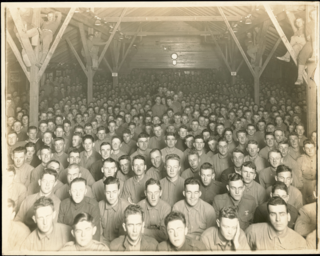
The Commission on Training Camp Activities (CTCA), also popularly known as the Fosdick Commission, was an umbrella agency within the United States Department of War during World War I that provided recreational and educational activities for soldiers as they trained for combat. Established in April 1917, the CTCA had the mandate to keep American troops "physically healthy and morally pure", while also motivating them to fight.